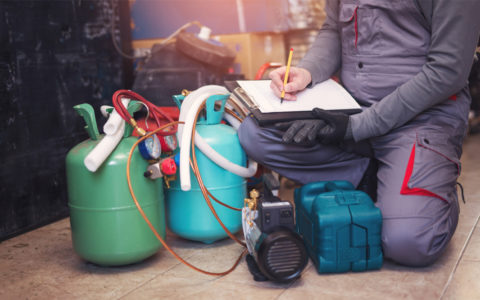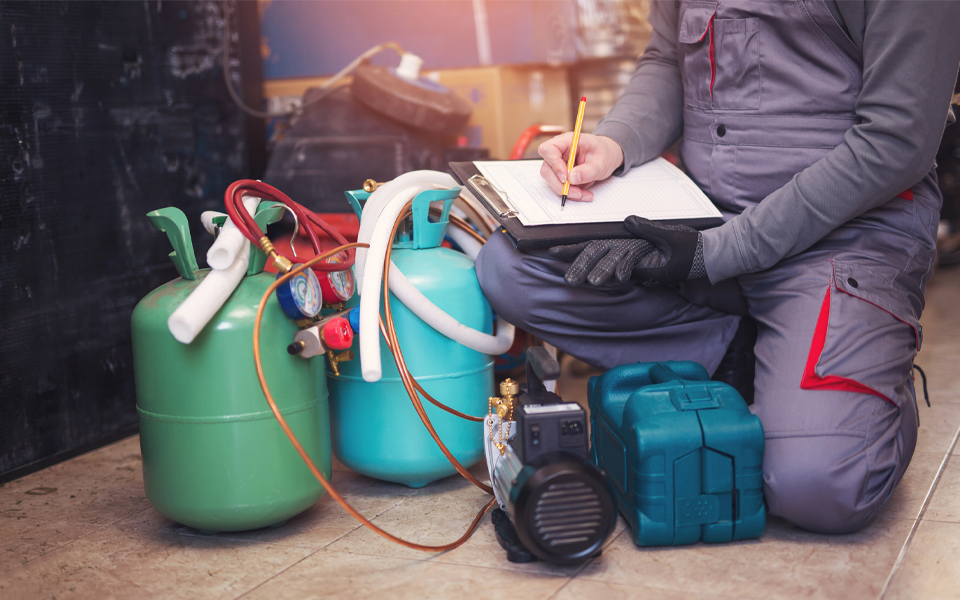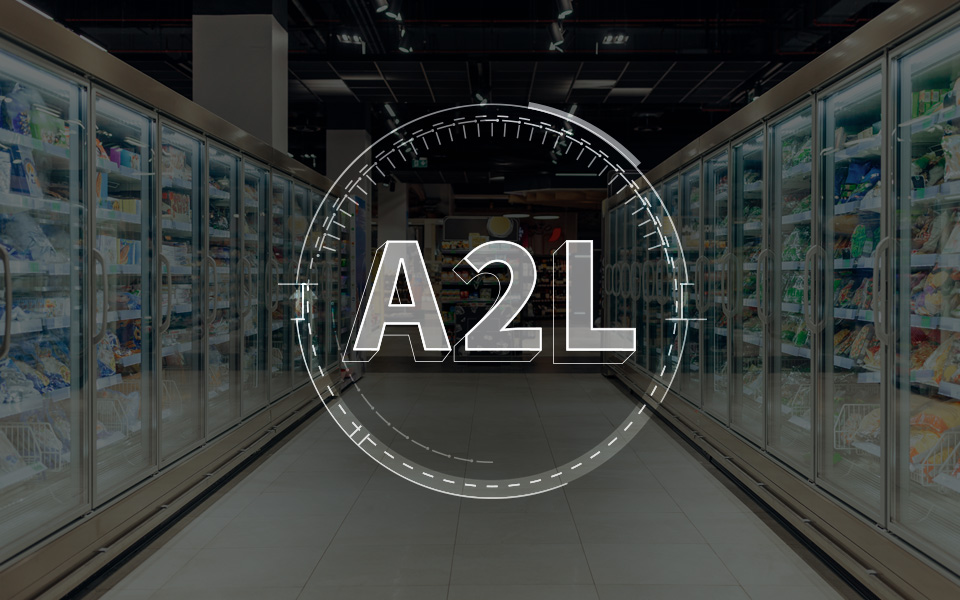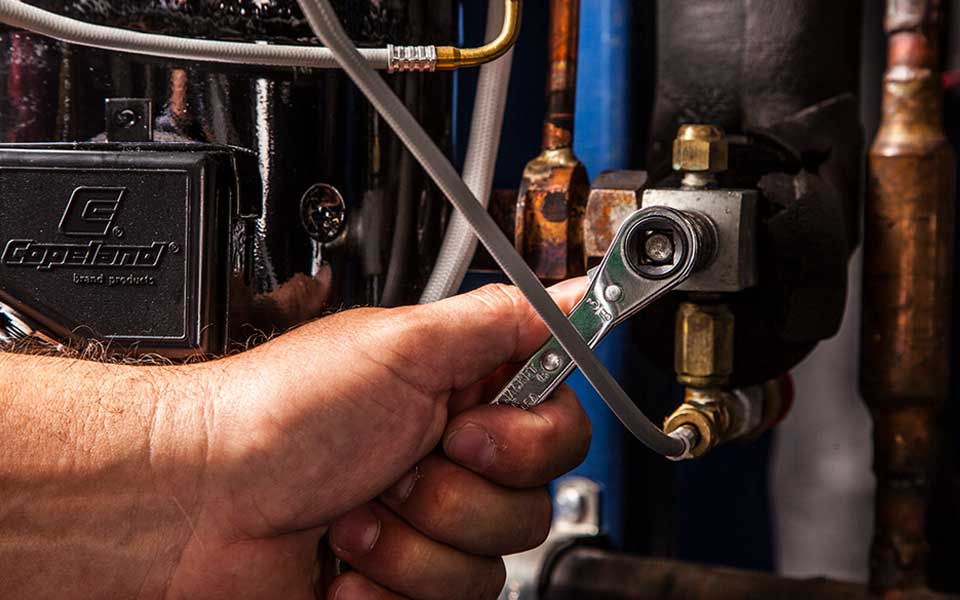Keys to servicing A2L refrigerants

*On June 1, 2023 Emerson’s Climate Technologies business became a new standalone company – Copeland. Though our name has changed, we are building on more than a century of HVACR innovation and industry leadership, and Copeland continues to offer the same products, industry stewardship, and learning opportunities you’ve grown to trust. Information found on this webpage posted before June 1, 2023 may contain our old name or branding, but you can be at ease knowing it was created with the knowledge and expertise of Copeland.
The refrigerant transition is underway, and HVACR service technicians find themselves at the leading edge. As the commercial refrigeration and AC industries move from high-global warming potential (GWP) hydrofluorocarbon (HFC) refrigerants to lower-GWP alternatives, mildly flammable A2L refrigerants are viewed as viable alternatives. But the technician community is largely unfamiliar with A2L servicing requirements and has many questions that need to be answered. I recently participated in an article for RSES Journal, in which we discussed the emergence of A2Ls and reviewed key servicing best practices. You can also view the article here.

Regulatory efforts to approve A2L refrigerants took several steps forward in 2021. The Environmental Protection Agency’s (EPA) Significant New Alternatives Policy (SNAP) Rule 23 approved R-454B and R-32 for use in residential AC applications, subject to use conditions. In addition, the UL approved the second edition of its UL 60335-2-89 standard that included A2L charge limit guidelines for self-contained and remote refrigeration systems. Although the UL 2-89 update was a major development, more regulatory approvals will be required to roll out A2Ls on a broader scale. Industry stakeholders expect EPA guidance and SNAP approvals for the use of A2L refrigerants in commercial refrigeration to happen soon.
But if you’re an HVACR technician, the chances of encountering A2Ls are on the rise. To maximize safety and assist your customers with installation and service calls, now is the time to gain a better understanding of A2Ls.
Back to basics with best practices
Thankfully, the transition from existing refrigerants to A2Ls won’t require a fundamental shift in the way you conduct service calls. But it will require more rigorous attention to basic servicing fundamentals. Existing recommended best practices for A1 refrigerants will apply — with the addition of a few special considerations and A2L-rated tools.
The potential for flammability makes the use of leak sensors and detection equipment a more important system consideration with A2Ls. Otherwise, A2Ls have very similar characteristics and pressures as common A1 HFC refrigerants, such as R-410A. It’s also important to be aware that some blended refrigerants, such as R-454B, will have a degree of glide.
When installing or repairing A2L refrigerant-based equipment, technicians will need to use A2L-rated gauges and tools and wear proper personal protective equipment (PPE). Compared to A1 procedures, there are some required steps when dealing with A2Ls that are considered best practices for A1 systems:
-
- Purge the circuit with inert gas (i.e., oxygen-free nitrogen).
- Evacuate the refrigerant.
- Leak-test and pressure-test the unit.
A2L cylinders have the same rated pressure as current R-410 cylinders. To make sure an A2L refrigerant is not mistaken for an A1, A2L tanks have several distinguishing characteristics, including:
-
- Pressure relief valve is designed to release only enough refrigerant to reduce the cylinder pressure.
- Red band/stripe (or the entire top painted red) indicates the presence of a mildly flammable refrigerant.
- Left-hand (LH) thread indicates the presence of an A2L refrigerant.
It’s important to remember that all HVACR equipment must be designed and rated for the use of A2L refrigerants. As such, A2Ls are not to be used as drop-in replacements for A1s in existing HFC systems. When charging refrigeration systems with an A2L, technicians must ensure that they do not exceed the maximum allowable charge rate.
Look for safety labels on A2L-based HVACR equipment to alert you of additional precautions. Some may also include a panel designed to cover service ports. For more information, please visit the Air-Conditioning, Heating, & Refrigeration Institute’s (AHRI) Safe Refrigerant Transition Task Force website (https://www.ahrinet.org/saferefrigerant).
A2L training is available
As A2L refrigerants make their way into U.S. AC and commercial refrigeration applications, industry organizations, manufacturers and stakeholders are working together to prepare for their wider adoption. At Emerson, we are actively developing A2L-certified compressors, condensing units and components to support the transition to lower-GWP refrigerants in commercial refrigeration and residential AC applications.
In addition, Emerson Educational Services is developing and conducting A2L training seminars as part of our “Fit for the Future” initiative. To prepare your service team to safely install, service and recover A2L refrigerants, please visit our course schedule.

A2L Refrigeration Overview — Systems, Safety and Servicing Considerations
by Joe Summers | HVACR Industry & Tech Tips
*On June 1, 2023 Emerson’s Climate Technologies business became a new standalone company –...

Servicing the Next Generation of Lower-GWP Refrigerants
by Joe Summers | HVACR Industry & Tech Tips
*On June 1, 2023 Emerson’s Climate Technologies business became a new standalone company –...

Improve Food Safety by Shifting to Proactive Measures
by Dan Knauer | HVACR Industry & Tech Tips
*On June 1, 2023 Emerson’s Climate Technologies business became a new standalone company –...
The post Keys to Servicing A2L Refrigerants appeared first on Copeland.